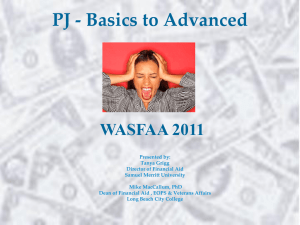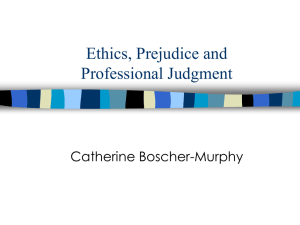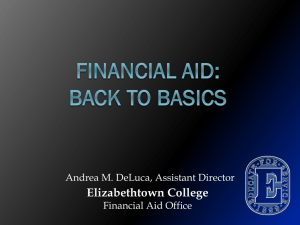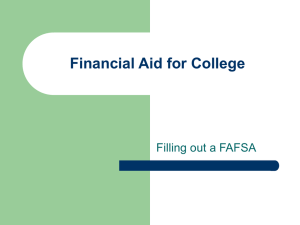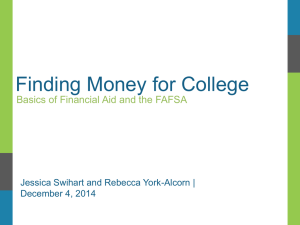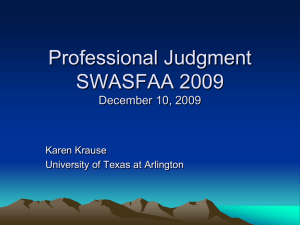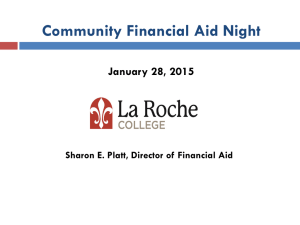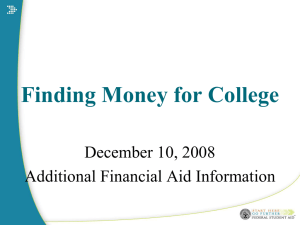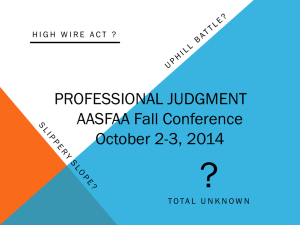Professional Judgement
advertisement
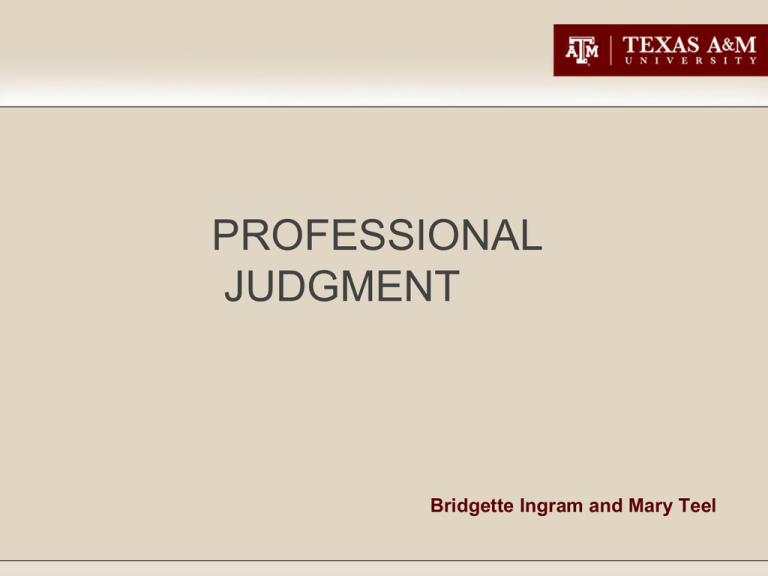
PROFESSIONAL JUDGMENT Bridgette Ingram and Mary Teel • Agenda –Define professional judgment –Scenarios –TAMU Process Flow Professional Judgment is • A mechanism for a financial aid administrator to exercise discretionary action for unusual circumstances that affect a student’s and/or parent’s ability to pay for educational expenses. • Financial aid professionals are all given authority by the Secretary of Education to exercise professional judgment. • An aid administrator may use professional judgment on a case-by-case basis only to alter the data used to calculate the EFC. • Act as if every professional judgment will be reviewed in an audit. • PJ’s can only occur with supplemental information. You must be able to distinguish between changes in a family’s circumstances that are a function of choice, and those that are a function of necessity. Using this will help you distinguish expenses that you should or should not consider. • Remember you are given the authority ! • Every financial transaction has a receipt….. Documentation is a MUST • When in doubt use your life lines – Poll the audience (your peers, your supervisor) – Phone a friend (someone at another college) – Eliminate options (tell the student what you can do) What to do? • Take emotion out of the equation • Ask for documentation (documentation will tell the story) • What meets the measure of an exception? Is the circumstance individual, meaning it is not something that has happened to a class of students. • “Decision making, is it informed, repeatable, unemotional, not personal and documentable?” (NASFAA presentation) What are some unusual circumstances ? • • • • • • Loss of employment Loss of benefits Medical expenses Separation or divorce Death (parent, spouse) Expecting the birth of a child or addition to the household • Nursing home expenses, not covered by insurance. Documentation What do I ask for? • It is unlimited. • You ask for what you believe will assist you in evaluating the particular review that you are doing. • What items are best: – Third party letters – Memos – Tax documents – Financial statements – Receipts Did you know? • Bottom Line Adjustments to an Estimated Family Contribution (EFC) is PROHIBITED! • You should understand the Federal Methodology and how each data element is treated. Did you know? • These circumstances do not warrant dependency overrides: – Parents refusal to contribute to educational costs. – Parents unwilling to provide information on FAFSA or TASFAA or for verification of the file. – Parents do not claim the student as a dependent. – Student demonstrates total self-suffiency. NO PJ Allowed! • Cannot use PJ to make a an otherwise ineligible student eligible for aid. • Cannot use to circumvent law or regulations – Under no circumstance can an FAA grant a Stafford loan for a student who is less than half time. – May not grant PJ for post enrollment activities, professional licensing exams In today’s economic times…. • Recent information - 2/3 of institutions saw a 10% increase in request for PJ’s. • The Dept. of Ed has encouraged making adjustments for those who need them. • Could there be different scenarios from what we have seen in the past (beyond unemployment)? – Salary cuts – Hardship withdrawals from retirement to cover medical bills. Types: • Unsubsidized loan for dependent students when parent refuses to fill out the FAFSA • Adjustment to FAFSA data for extenuating circumstances • Dependency Override • Cost of Attendance increase From the handbook (application and verification guide chap 2) You must get documentation (1) that his parents refuse to provide information for his FAFSA and (2) that they do not and will not provide any financial support to him. Include the date support ended. If the parents refuse to sign and date a statement to this effect, you must get documentation from a third party (the student himself is not sufficient), such as a teacher, counselor, cleric, or court. Scenarios Unsubsidized loan for dependent • Kristen wanted to come to Texas A&M University and her parents were adamantly against it. They wanted her to go to a local college. The parents wrote a letter stating they would not support her financially and would not fill out their information on the Free Application for Federal Student Aid (FAFSA). What would you do? Adjustment to FAFSA • Kitty’s mother had income earned from work of $25,000 in 2011 but is no longer employed for 2012. After receiving documentation confirming this, What would you do? Adjustment to FAFSA • In 2011 Alan had $2,850 in medical expenses that were out-of-pocket costs. He is married, has two children, and is the only member of his household in college, so his IPA is $33,300. What would you do? Adjustment to FAFSA • John (the parent) converted his regular IRA into a Roth IRA by transferring funds. The amount converted has to be reported as taxable income on the tax return. So the income reported on the FAFSA will be higher than without the Roth conversion, even though the family doesn’t actually have additional income or assets available. What would you do? Dependency Override • Ryan has had no contact with his Mom since he was 3 years old. He has lived with his Dad who is an alcoholic and verbally abusive. He lived with his Dad all but a few months at the end of high school and checks on him every now and then. Documentation has been received from his high school teacher. What would you do? Dependency Override • Alyshia submitted documentation explaining that her parents would not support her through college because of the boy she was dating. What would you do? Dependency Overrides! • What circumstances have you used? • What documentation have you requested to do this? - What if a parent does not like a students boyfriend or girlfriend? - What if a parent does not want to release tax data? - What if the student has lived with neighbors or a teacher due to abuse at home? Cost of Attendance • Henry is a graduate student who moved from Oklahoma. He is asking for an increase for moving expenses, U-haul rental, gas for U-haul, in addition to the deposits he had to pay for an apartment and electricity. He feels these cost fall under educational expenses to attend TAMU. What would you do? Cost of Attendance • Freddie submitted a request that he needs to pay his rent ($400 month), pay electricity ($125 month) and has short term loans to pay off. His parents bought him a car so he needs to pay the difference and have insurance. He eats out a lot because he is very busy. What would you do? Cost of Attendance • Heather states that she broke her arm and has had to pay over $1000 in out of pocket medical expenses she had not planned for during this semester. She is now short funds to pay her November and December rent. What would you do? TAMU Process Flow About Us • Approximately 800 professional judgments processed to date for 20122013. • Average processing time 5 to 7 business days. Professional Judgment Flow Student submits CRF w/documents Documents scanned into our Imaging System and sent to Workflow If student file has not been verified, we verify original data on FAFSA Assistant Director assigns CRF to Advisors for review/processing Contact student for additional documents or clarification if needed If approve-update Banner and/or FAA Access (D.O.) and notify student If Denied—notify student and enter notes on Banner Submit Professional Judgment Worksheet to Imaging and documentation for approval or denial Clear from workflow Banner Schools Tidbit • Use RNINAIQ to determine components of federal methodology. Resources • • • • • NASFAA website NASFAA Monograph 26 HEA Sec 479A(a) Federal Student Aid Handbook Dear Colleague Letters GEN-09-04 and GEN 09-05 and 2010-05-21, 2010-05-05 Final Thoughts • Advocate for students and parents • Respect others professional judgment • Don’t forget to DOCUMENT

